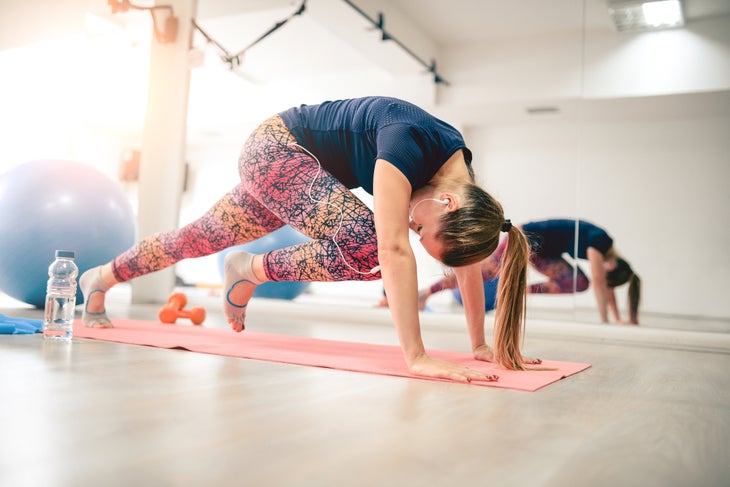Get access to everything we publish when you
sign up for Outside+.
The benefits of regularly performing core exercises goes well beyond supporting the pursuit to get washboard abs. More importantly, a strong core can improve your overall fitness, make you a more efficient runner, and decrease your risk of injury. That said, if you’ve put in the time and too many thousand crunches to count, but have yet to see or feel the results, you may feel like there’s no point to focusing on your core.
The problem may be in the core exercises themselves. Gone are the days where trainers prescribed countless sets of crunches and sit-ups to hopefully deliver on the promise of chiseled abs. Instead, the best core exercises for women move the focus from just the abs to the entire core, and include functional movements that translate to running, other physical activities, and everyday life. So, if you’re tired of doing endless crunches, keep reading for our guide to the best core exercises for women—and get ready to enjoy the benefits of strengthening your entire midsection.
What is the Core?
Trainers, running coaches, and fitness professionals often throw around the term “core,” but many runners aren’t entirely sure what is included. The core refers to all the muscles in the trunk, from the diaphragm to the pelvic floor in a 360-degree perspective. Thus, the “core” includes the following muscles:
- Diaphragm
- Rectus abdominis (the “six-pack” muscles down the center of your abdomen)
- Internal and external obliques (the muscles on the sides of your abs)
- Transverse abdominis (a deep core muscle that wraps around your abs and is heavily involved in stability)
- Psoas major and minor (connect from the inside of the spine and pelvis to the hip)
- Erector spinae (spinal extensors)
- Pelvic floor muscles
- Glutes
RELATED: The Best Exercises Runners Can Do to Prevent Lower Back Pain
Benefits of Core Exercises for Women
Your core muscles work together to help you move your trunk. Since the core functions to connect your upper body and lower body, having a strong core will improve your movement efficiency and provide a host of benefits, including the following:
- Reducing the risk of back pain
- Reducing the risk of injury
- Stabilizing your hips and spine
- Improving coordination and balance
- Improving muscle tone and definition
- Improving running economy
- Improving breathing efficiency
- Increasing overall strength, especially when coupled with a well-rounded strength training program
- Reducing the risk of incontinence
- Increasing the mind-body connection
- Faster return to running after pregnancy
- Improving the ability to maintain proper running form during long runs and races
Best Core Exercises for Women

Everyone can benefit from performing core exercises, but women may experience additional challenges and body changes over their life that make strengthening the core even more important. For example, hormonal changes and the physical stress of pregnancy can overstretch or even rupture abdominal muscles and may cause weakening of the pelvic floor muscles. After menopause, women may experience hormonal shifts that cause changes in abdominal fat distribution, which can cause back pain. Strengthening your core can help prevent or correct muscle imbalances and discomforts that can occur and may help preserve your functional performance. Below, we share six of the best core exercises for women.
1. Planks
You don’t have to hold a plank for minutes on end or take part in a social media plank challenge to reap the benefits of this exercise. A plank is considered an anti-rotation exercise, which is why it’s such an effective core exercise for runners. If you think about the function of the core, particularly while running, it is to serve as a stable base of support for your moving upper and lower limbs. A plank helps train your core to be stable. Instead of professing by holding the movement for longer periods of time, it’s more effective to advance the move by modifying the static basic plank with movements. For example, lift one limb off the ground at a time. This will better mimic the real-life demands on the core.
How to do it:
- Get into a push-up position, but drop down so that your forearms are on the floor with your elbows directly underneath your shoulders.
- Squeeze your glutes and engage your abs by drawing your belly button up to your spine. Your body should be in a straight line from your head to your feet.
- Hold the pose, breathing normally for 30-60 seconds.
When you’re ready to progress, lift up one arm or leg at a time for 2-3 seconds.
2. Dead bug
This core exercise will strengthen your lower abs and pelvic floor muscles.
How to do it:
- Lie on your back with your knees bent to 90 degrees, shins parallel to the floor, and arms pointing straight up towards the ceiling.
- Inhale, engaging your abs, then slowly lower one foot towards the floor until your toe nearly taps down while simultaneously extending the opposite straight back behind you towards the floor without touching it.
- Keep the other leg and arm steady at the starting position.
- Raise the leg and arm back to the starting position and repeat with the opposite leg and arm.
- Alternate sides with each rep, moving slowly and with control.
- Complete 15 reps per side.
As you get stronger, you can use ankle weights for added resistance.
RELATED: The Best, Worst Workout I’ve Ever Done: This StairMaster Workout For Runners
3. V-ups with stability ball
This exercise strengthens your abs and psoas, and by squeezing the stability ball in between your legs, you’ll also engage your pelvic floor.
How to do it:
- Lie on your back with your legs extended, squeezing a stability ball as hard as possible between your ankles. Your arms should be extended straight up over your head.
- Use your core to simultaneously lift your legs and upper body off the floor so that you’re folding your hips into a “V” shape with your body.
- Pass the ball from your ankles to your hands.
- Slowly lower your body back towards the floor without fully touching it so that your legs are just hovering over the floor and the ball and your arms are reaching back behind you but not touching the floor.
- Lift back up to the “V” position and pass the stability ball back to your ankles.
- Squeeze it as you slowly lower again.
- Complete 12-15 reps.
4. Side planks with rotation
Side planks target your obliques, erector spinae, and transverse abdominis. This modification further challenges your core by requiring stability while you move your upper body. Use a relatively light dumbbell (5 pounds or so) when you start.
How to do it:
- Lie on one side with your elbow stacked directly under your shoulder and feet stacked on top of one another.
- Lift your hips off the ground and extend your top arm up straight up towards the ceiling holding a dumbbell.
- Slowly rotate your pelvis towards the floor while reaching the dumbbell underneath your body, bringing the dumbbell to tap your shoulder blade in the back.
- While maintaining your balance, rotate back to the starting position, raising the dumbbell back up into the air.
- Complete 12 reps per side.
5. Bird dog
Running can cause low back pain if your core is weak, particularly if your posture is poor. This core exercise encourages lengthening the spine and will strengthen your spinal stabilizers and glutes.
How to do it:
- Get in a tabletop position by kneeling on all fours with a flat back and wrists under your shoulders.
- Simultaneously lift and extend your opposite arm and leg, maintaining balance. Reach your arm forward so that it’s straight and parallel to the floor and lift your leg straight back so that it’s also parallel to the floor.
- Bring them back to the starting position but before you drop them back down to rest, move past the neutral starting position to touch the elbow and knee together in a crunch underneath your chest.
- Repeat on the opposite side.
- Continue alternating sides, until you’ve completed a total of 30 reps, moving as slow and controlled as possible.
6. Pallof press
This is another anti-rotational exercise that works your obliques, shoulders, and abs. You’ll need a resistance band, and you can modify the difficulty of the move with the width and thickness of the resistance band you choose. Use a thinner band for an easier exercise and a wider, thicker band as you get stronger.
How to do it:
- Attach a resistance band with a handle to a pole or stationary object. You can perform the exercise kneeling or standing, but the band should be chest height and you should be far enough away from the anchor point that there’s a good amount of tension on the band.
- Hold the handle of the band in towards your chest.
- Brace your core and contract your glutes, and then straighten your arms by pushing them out away from your chest against the tension of the band.
- Hold this extended position for a full breath and then return your arms to your chest.
- Complete 15 slow reps.
RELATED: 4-Week Plans to Dial Up Your Running, Nutrition, and Cross-Training
